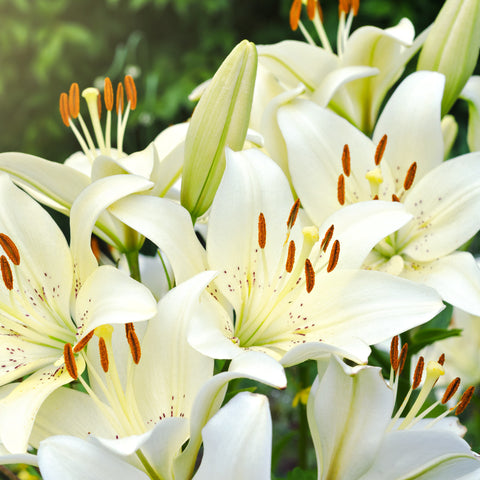Although it's fairly simple to grow flowers from bulbs, some people might find it too inconvenient to buy the right potting mix and fertilize the soil regularly. This is why some gardeners prefer growing their flower bulbs in water instead of soil. This process is called forcing the bulbs.
Instagram reels are filled with gardening influencers growing their own flowers by submerging bulbs in water. And this technique of forcing bulbs indoors is a great way to bring the beauty of flowers into your home without worrying about soil health. By growing bulbs in water, you can enjoy colourful blooms even when it’s not possible for you to grow them in the soil outside.
Here's our guide to help you get started.
What is Forcing Bulbs?

In simple terms, forcing bulbs refers to the practice of encouraging bulbs to bloom without the soil by providing the right conditions in water indoors. It’s a method that takes advantage of the plant's natural growth cycle and accelerates it, so you can enjoy flowers indoors before the spring season. You’ll need to mimic the winter conditions that bulbs typically experience in nature to trigger their bloom cycle. This is typically done by chilling the bulbs for a certain period and then bringing them into a warmer, brighter environment to grow.
Varieties of Bulbs You Can Grow Indoors in Water

Not all flower bulbs can be forced indoors, but there are several spring and autumn varieties that do exceptionally well in water. Here are some popular options:
Spring Bulbs:
- Tulips – 12–16 weeks to bloom
- Daffodils – 12–16 weeks to bloom
- Hyacinths – 8–10 weeks to bloom
- Crocuses – 8–10 weeks to bloom
- Snowdrops – 10–12 weeks to bloom
Autumn Bulbs:
- Amaryllis – 6–8 weeks to bloom
- Narcissus (Paperwhites) – 4–6 weeks to bloom
- Freesia – 12–14 weeks to bloom
- Gladiolus – 10–12 weeks to bloom
Important:
Most bulbs will require prechilling before you can begin forcing them indoors. Prechilling is a process where you place the bulbs in a cold environment (such as a fridge) for a specific period (usually 12–16 weeks) to mimic the natural winter conditions. This is particularly important for bulbs like tulips and daffodils, which require a cold period to trigger flowering later.
Choosing Containers to Grow Bulbs in Water

When growing bulbs in water, choosing the right container is key. Ideally, the best containers for this purpose are clear glass jars or vases. The transparency allows you to see the roots as they develop, adding to the charm of the process. The container should have a narrow opening that gently holds the bulb in place, so the bulb doesn't submerge completely in the water—only the roots should touch the water. However, you can also use any wide glass container for this and arrange seasonal bulbs of different varieties for a packed display of flowers.
Process of Growing Bulbs in Water Indoors

Once your bulbs are prechilled and you’ve selected your container, it’s time to start the process of forcing your bulbs indoors.
Step 1: Clean the Container
Before you start, ensure the container is clean and free from any dust or residues. A quick rinse with warm soapy water will do the trick.
Step 2: Position the Bulb
Place the bulb in the container, making sure that the base of the bulb is just above the water line. The roots will eventually grow down into the water. The pointed end of the bulb should face upwards. Place some gravel or stones at the base of the container. You don’t want the bulb to sit directly in the water, as this could cause it to rot.
Step 3: Fill the Container with Water
Fill the container with water, ensuring that the water level reaches just below the base of the bulb. Keep the water level low enough that only the roots will contact the water.
Step 4: Place near a bright sunlit window
Place the container in a bright, sunny spot, preferably somewhere with bright indirect light. This will encourage the bulbs to start growing towards the light, and you’ll soon begin to see the shoots and flowers develop. Very bright direct sunlight will cause the container to get too hot and may result in sun damage to the growing bulb.
Step 5: Change the Water Regularly
It’s essential to change the water every 3-4 days to keep it fresh and prevent any stagnant water that might cause the bulbs to rot. Always use room-temperature water for this. Also, keep checking the base of the bulbs for any signs of fungal growth every time the water is being changed.
Tips for Encouraging More Blooms

To encourage even more blooms, you can try adding a few simple ingredients to the water. A small amount of sugar or a liquid fertilizer can help provide extra nutrients, which in turn can promote more flowers. Some gardeners also recommend adding a bit of clear alcohol to the water (about 1 teaspoon per vase) as it slows down the growth a little, allowing the bulb to put more energy into producing flowers instead of excessive foliage.
Lastly, ensure your bulbs have a cool but well-lit environment for the best results. Avoid placing them in hot, direct sunlight, as this can cause them to wilt prematurely. When all the flowers have bloomed and there are no new buds appearing, it is time to put the bulbs in the compost pile
Forcing bulbs indoors is a fun and satisfying way to grow flowers in the comfort of your own home without ever touching any soil. By following these steps—choosing the right bulbs, and containers, and prechilling them before starting—you’ll be able to enjoy colourful blooms indoors. Order your favourite flower bulbs today and try this method at home.
Happy Gardening!


 Sign In
Sign In


















Let us know your feedback
* Comments must be approved before being displayed.